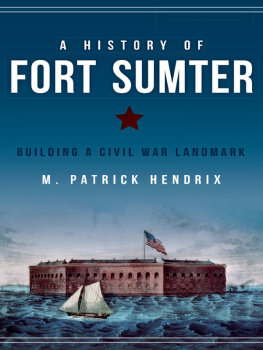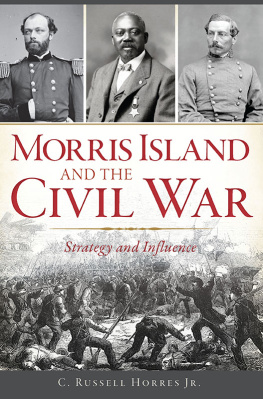

Published by The History Press
Charleston, SC 29403
www.historypress.net
Copyright 2014 by M. Patrick Hendrix
All rights reserved
All images are courtesy of the Library of Congress.
First published 2014
e-book edition 2014
ISBN 978.1.62585.008.9
Library of Congress Cataloging-in-Publication Data
Hendrix, Michael Patrick, 1972
A history of Fort Sumter : building a Civil War landmark / M. Patrick Hendrix.
pages cm
Includes bibliographical references and index.
print edition ISBN 978-1-62619-470-0 (paperback)
1. Fort Sumter (Charleston, S.C.)--History. 2. Fortification--South Carolina--Charleston--Design and construction--History--19th century. 3. Charleston (S.C.)--Buildings, structures, etc. 4. Charleston (S.C.)--History--Civil War, 1861-1865. 5. Soldiers--Confederate States of America--Biography. 6. Soldiers--United States--Biography. 7. Charleston (S.C.)--History--Civil War, 1861-1865--Biography. 8. United States--History--Civil War, 1861-1865--Biography. I. Title.
F279.C48F685 2014
975.7915--dc23
2014003549
Notice: The information in this book is true and complete to the best of our knowledge. It is offered without guarantee on the part of the author or The History Press. The author and The History Press disclaim all liability in connection with the use of this book.
All rights reserved. No part of this book may be reproduced or transmitted in any form whatsoever without prior written permission from the publisher except in the case of brief quotations embodied in critical articles and reviews.
CONTENTS
ACKNOWLEDGEMENTS
I would first like to like to thank Toni Hendrix and Judy Corbett for their contributions on this project. Their editing was a godsend. Danna Gosney and Eric Poplin also helped edit and gave many useful insights. Additionally, I would like to express my gratitude to the staffs at The History Press, Fort Moultrie, the Charleston Public Library, The Citadel Military College and the South Caroliniana Library. Finally, I would like to thank Steven Smith, an archaeologist with the South Carolina Institute of Archaeology and Anthropology who gave my last book a particularly nasty review. After an initial moment of anger where I mightve referred to Dr. Smith as a vicious skunk or much worse, I figured any publicity was better than no publicity. I was mistaken. Turns out only the terminally dull or mentally deranged would read something called The Public Historian. Alas, no bump in sales. I do, however, thank Steven for his insights and wanted to mention him here so that his name might appear in a publication that human beings actually read. (This is, of course, all in good fun.)
Hope you enjoy it. If you dont, Im putting you in the acknowledgements of my next book.
PH
CONCEPTION
It was an uneasy night in August 1814. Enduring the hottest summer anyone could remember and plagued by the malarial swamps surrounding the city, Washingtons residents awoke on August 24 to hear that thousands of battle-hardened veterans of the Napoleonic Wars were marching from the Chesapeake Bay and their arrival was imminent. With the capitals defenses in hopeless disrepair, Washingtons prospects looked grim, and half the city fled in advance of the British Expeditionary Force.
By midafternoon on the twenty-fourth, 4,500 British troops were just miles from the city when a combined force of U.S. Army regulars, marines and militia tried one final stand at the town of Bladensburg, Maryland. President James Madison and most of his cabinet were in attendance as the Americans opened the engagement with artillery and small arms fire. The Americans were soon thrown back by the Forty-fourth Regiment of Foot, and the American lines soon crumbled and fell away. Though Commodore Joshua Barneys flotilla men and Captain Samuel Millers marines tried to rally, by four oclock, the Americans were finished.
As darkness approached, General Robert Rosss Expeditionary Force reconnoitered at the outskirts of Washington. After a brief pause to organize his forces, Ross sent word to the citys residents to surrender. When his terms were answered with musket fire from a nearby window, this breach of the law of nations, roused the indignation of every individual, from the General himself down to the private soldier. All those found where the shots were fired were executed, and the house was torched. As the sun edged below the horizon, British forces marched to Capitol Hill and proceeded to destroy everything in the most distant degree connected with government. British soldier George Robert Gleig reported that his compatriots arrived to see that the sky was brilliantly illuminated. He recalled:

The White House after its destruction by the British during the War of 1812.
The blazing of houses, ships, and stores, the report of exploding magazines, and the crash of falling roofs informed them, as they proceeded, of what was going forward. You can conceive nothing finer than the sight which met them as they drew near to the towna dark red light was thrown upon the road, sufficient to permit each man to view distinctly his comrades face.
As the British troops delighted in burning Washingtons public buildings, another detachment was sent to Mr. Madisons house, where they found the White House dinner table prepared for forty guests, though lately and precipitately abandoned. After sitting down to enjoy wine and a meal served on the presidents finest plate, they finished by setting fire to the house which had so liberally entertained them.
With Washington in ruins and the country heading toward insolvency, the United States was undoubtedly taking a beating. But where the Republic failed on the battlefield, it would triumph in a sort of strategic default. The British could burn Washington and chastise the savages, but outright victory over the Americans could only be accomplished by mobilizing tens of thousands of Napoleonic Wars veterans. While the British press called for complete submission, after calculating the logistical difficulties and political risks, British policymakers decided that the strategic accounting didnt add up.
Looking to end the war, both sides met in Belgium and signed the Treaty of Ghent on December 24, 1814. Recognizing the United States as an equal of sorts, Great Britain relinquished claim to the Northwest Territory and accepted most of the American demands. Adding insult to injury, or perhaps vice versa, on January 8, 1815, Major General Andrew Jacksons combined force of American Regulars, Choctaws, frontiersmen, African American freemen, marines and sailors routed eight thousand British Expeditionary troops as they marched on New Orleans. In under an hour, the Americans turned the British columns into a bloody wreck, killed commanding officer Major General Sir Edward Pakenhambrother-in-law to the Duke of Wellingtonand forced a British officer to surrender to a private of the Seventh Infantry as the American troops laughed. Jacksons dramatic victory not only avenged the burning of Washington but also prophesied a new empire that would, as one contemporary put it, give quiet to the world.
With the War of 1812 over, the country faced no imminent security threats. But soon, the French and British would get back to killing someone, and it was best to plan to plan for that eventuality. England was determined to maintain a powerful military presence in the Western Hemisphere, making it inevitable that the two countries imperial ambitions would create new conflict. For their part, the French proved capable of trouncing all comers save the Russian winter, and their endless squabbles with the British always threatened to drag the United States into war. Even the Spanish Empire, then in precipitous decline, still endangered not only the Republics security, tranquility, and commerce but also, as Thomas Jefferson warned, its very destiny to give the law to our hemisphere. Senator Henry Clay cautioned that unless Americans wanted to abandon the Ocean; surrender all your commerce; give up all your prosperity, it would be necessary to prepare for foreign collision.
Next page










